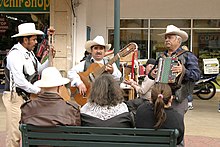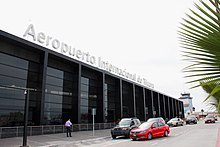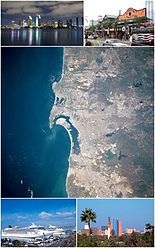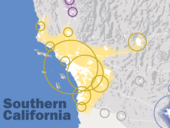Culture Of Tijuana
Tijuana is the 27th largest city in the Americas and is the westernmost city in Mexico. As of 2024, the population of Tijuana has increased to 2,297,000, reflecting a growth of 1.63% since 2023. The city was second-largest nationally with 1,810,645 inhabitants. The international metropolitan region was estimated at 5,158,459 in 2016, making it the third-largest metropolitan area in The Californias, 19th-largest metropolitan area in the Americas, and the largest bi-national conurbation that is shared between US and Mexico. The city is one of the fastest-growing metro areas in the country and rated as a "High Sufficiency" global city by the Globalization and World Cities Research Network.
Tijuana traces its modern history to the arrival of Spanish colonists in the 16th century who were mapping the coast of the Californias. Following the division of the Californias after the American Conquest of California, Tijuana found itself located on an international border, giving rise to a new economic and political structure. The city was incorporated on 11 July 1889 as urban development began. The city has served as a major tourist destination since the 1880s. Today, Tijuana is a dominant manufacturing center for North America, hosting facilities of many multinational conglomerate companies. In the early 21st century, Tijuana has emerged as the medical device manufacturing capital of North America and is increasingly recognized as an important cultural Mecca for the border region of The Californias. The city is the most visited border city in the world, sharing a border of about 24 km (15 mi) with its sister city San Diego. More than fifty million people cross the border between these two cities every year.
Despite its popularity as a tourist destination, Tijuana is a hotbed of crime, especially violent crime, due to the extensive presence of organized crime and Mexican cartels. It regularly ranks among the most violent cities by homicide rate. According to Statista in August 2023, Tijuana presently has the second highest homicide rate in the world. The U.S. State Department maintains a travel advisory warning as of September 2023 relating to the city's "non-tourist areas". Incidents involving the murder or kidnapping of foreigners since the 2000s have also sparked travel fears and affected Tijuana's status among international tourists.
Name
The city's name comes from the rancho that Santiago Argüello Moraga established in 1829 on his Mexican land grant, naming it Rancho Tía Juana.
The first Spanish mission referred to the settlement variously as Rancho Tía Juana, Tihuan and finally, Tijuana. While the city was founded as “Tijuana” in 1889, "Tia Juana" remained the English-language name for the river, as well as a U.S. settlement that is now part of San Ysidro, until approximately 1916.
The commonly accepted theory among historians is that Tía Juana, as Argüello named his rancho, is derived from the word Tiwan ("by the sea") in the language of the Kumeyaay—the First Nations people of the San Diego-Tijuana region. Urban legend, on the other hand, states that Tía Juana, which means "Aunt Jane" in Spanish, was a real person whose inn provided food and lodging to travelers. There is, however, no record of such an inn; in fact, the first building in the area was built by Argüello in any case, after naming his ranch Rancho Tía Juana.
In California, Tijuana is often referred to as T.J.
History
The land was originally inhabited by the Kumeyaay, a tribe of Yuman-speaking hunter-gatherers. Europeans arrived in 1542, when colonist Juan Rodríguez Cabrillo toured the coastline of the area, which Sebastián Vizcaíno mapped in 1602. In 1769, Juan Crespí documented more details about the area that was later called the Valley of Tijuana.
19th century
Further settlement took place near the end of the mission era when José María de Echeandía, governor of the Baja California and Alta California, awarded a large land grant to Santiago Argüello in 1829. This large cattle ranch, Rancho Tía Juana, covered 100 km (40 sq mi). Although "Tia Juana" means "Aunt Jane" in Spanish, the name was actually an adaptation of the word 'Tihuan' or 'Tijuán' in the Kumeyaay language, the name of a nearby Kumeyaay settlement and whose meaning is disputed.
In 1848, as a result of the Mexican–American War with the United States, Mexico lost Alta California. While the majority of the 1,000 Hispanic families living in Alta California stayed on the American side, some moved south to Tijuana to remain inside Mexico, which was now in Baja California as the division between the Californias moved north in between San Diego and Tijuana. Because of this Tijuana gained a different purpose on the international border. The area had been populated by ranchers, but Tijuana developed a new social economic structure which were farming and livestock grazing, plus as a transit area for prospectors.
Urban settlement began in 1889, when descendants of Santiago Argüello and Augustín Olvera entered an agreement to begin developing the city of Tijuana. The date of the agreement, 11 July 1889, is recognized as the founding of the city. Tijuana saw its future in tourism from the beginning. From the late 19th century to the first few decades of the 20th century, the city attracted large numbers of Californians coming for trade and entertainment. The California land boom of the 1880s led to the first big wave of tourists, who were called "excursionists" and came looking for echoes of the famous novel Ramona by Helen Hunt Jackson.
20th century

In 1911, during the Mexican Revolution, revolutionaries claiming loyalty to Ricardo Flores Magón took over the city for shortly over a month. Federal troops then arrived. Assisted by the "defensores de Tijuana", they routed the revolutionaries, who fled north and were promptly arrested by the United States Army.
The Panama–California Exposition of 1915 brought many visitors to the nearby California city of San Diego. Tijuana attracted these tourists with a Feria Típica Mexicana – Typical Mexican Fair. This included curio shops, regional food, thermal baths, horse racing and boxing.
The first professional race track opened in January 1916, just south of the border gate. It was almost immediately destroyed by the great "Hatfield rainmaker" flood of 1916. Rebuilt in the general area, it ran horse races until the new Agua Caliente track opened in 1929, several miles south and across the river on higher ground.
Legal drinking and gambling attracted U.S. nationals in the 1920s during Prohibition. The Avenida Revolución area became the city's tourist center, with casinos and the Hotel Caesar's, birthplace of the Caesar salad.
In 1925, the city by presidential decree changed its name to Ciudad Zaragoza, but its name reverted to Tijuana in 1929.

In 1928, the Agua Caliente Touristic Complex was opened, including hotel, spa, dog-track, private airport, golf course and gambling casino. A year later, the new Agua Caliente Racetrack joined the complex. During the eight years it operated, the Agua Caliente hotel, casino and spa achieved a near mythical status, with Hollywood stars and gangsters flying in and playing. Rita Hayworth was discovered there. Musical nightclub productions were broadcast over the radio. A singer known as "la Faraona" got shot in a love-triangle and gave birth to the myth of a beautiful lady ghost. Remnants of the Agua Caliente casino can be seen in the outdoor swimming pool and the "minarete" (actually a former incinerator chimney) nearby the southern end of Avenida Sanchez Taboada, on the grounds of what is now the Lázaro Cárdenas educational complex. A replica of the iconic bell tower (which once stood at the resort entrance) now stands at the beginning of Boulevard Agua Caliente, about two miles west of the old resort.
In 1935, President Cárdenas decreed an end to gambling and casinos in Baja California, and the Agua Caliente complex faltered, then closed. In 1939, it was reopened as a junior high school (now, Preparatoria Lázaro Cárdenas). The buildings themselves were torn down in the 1970s and replaced by modern scholastic architecture.
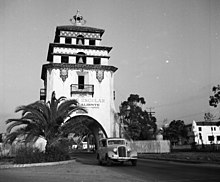
With increased tourism and a large number of Mexican citizens relocating to Tijuana, the city's population grew from 21,971 to 65,364 between 1940 and 1950. With the decline of nightlife and tourism in the 1950s, the city restructured its tourist industry, by promoting a more family-oriented scene. Tijuana developed a greater variety of attractions and activities to offer its visitors.
In 1965, the Mexican federal government launched the Border Industrialization Program to attract foreign investment. Tijuana and other border cities became attractive for foreign companies to open maquiladoras (factories), and the Tijuana economy started to diversify. Manufacturing jobs attracted workers from other parts of Mexico and the city's population grew from less than half a million in 1980 to almost 1 million in 1985.
In 1972, work began on the first concrete channeling of the Tijuana River; previously the river would flood across a wide plain east and southeast of downtown, inundating an area of cardboard and metal shacks called Cartolandia (“Paperland”). The project removed the shacks and added 1.8 million sq. m. of usable land, on which the Zona Río was built. With the 1981 opening of the Plaza Río Tijuana mall and the 1982 Tijuana Cultural Center (CECUT), Zona Río became the new commercial center of a modern Tijuana, and with its new boulevards with monument-filled glorietas (roundabouts), reminiscent of the grand Paseo de la Reforma in Mexico City, the city created the new image and allure of a modern, large city, rather than just a border town focused on tourism and vice.
In 1994, PRI presidential candidate Luis Donaldo Colosio was assassinated in Tijuana while making an appearance in the plaza of Lomas Taurinas, a neighborhood nestled in a valley near Centro. The shooter was caught and imprisoned, but doubts remain about who the mastermind might have been.
21st century

After 9/11, tighter US border controls resulted in hours-long waits to return to the US. The number of US visitors dropped sharply due to this factor, as well as subsequent drug violence.
Around 2008, thousands of Tijuana's elite bought houses in and moved to Bonita and Eastlake in Chula Vista, California, to escape violence, kidnapping and other crimes taking place during that period. An article in The Los Angeles Times reported that the emigration to San Diego County has transformed the demographic and cultural character of some cities to a degree.
In recent years, Tijuana has become an important city of commerce and migration for Mexico and US. In spite of the violence and border crossing issues, the city has received a large number of tourists from US, China, Japan and the south of Mexico. Thanks to the realization of cultural and business festivals, the city has improved its image before the world, standing out as a competitive city for investment. Currently, the commercial and business sector is committed to the boom in the gastronomic industry, craft beer, entertainment, and real estate, as well as medical tourism, to attract visitors and investors.
Geography

Tijuana is the westernmost city in Mexico, and consequently in Latin America, and the second-largest city in northern Mexico. Located about 210 kilometers (130 mi) west of the state capital, Mexicali, the city is bordered to the north by the cities of Imperial Beach, and the San Diego neighborhoods of San Ysidro and Otay Mesa, California. To the southwest of the city is Rosarito Beach, while to the south is unincorporated territory of Tijuana Municipality. The city is nestled among hills, canyons, and gullies. The central part of the city lies in a valley through which flows the channeled Tijuana River.
Housing development in the Tijuana Hills has led to eradication of many seasonal mountain streams. This lack of natural drainage makes places within the city vulnerable to landslides during the rainy season. The varied terrain of Tijuana gives the city elevation extremes that range from sea level to 790 meters (2,590 ft). As downtown Tijuana was built at the bottom of the river valley, the district is subject to seasonal flooding created by drain-off from the Tijuana Hills. During this time, east-bound portions of the Via Rapida (east–west highway) may be blocked off by the Tijuana Police due to hazardous conditions.
Tijuana is noted for its rough terrain, which includes many canyons, steep hills, and mesas. Large hills in Tijuana include the Cerro Colorado and the Cerro de las Abejas.
The city is located near the terminus of the Tijuana River and within the Tijuana River Basin. The Tijuana River is an intermittent river, 195 km (121 mi) long, on the Pacific coast of northern Baja California in Mexico and Southern California in the United States. It drains an arid area along the California–Baja California border, flowing through Mexico for most of its course and then crossing the border for the last 8 km (5 mi) of its course where it forms an estuary that empties into the ocean.
Cityscape

The city's skyscraper history is relatively recent. Some of the first highrise building complexes constructed in the city were the twin towers of Grand Hotel Tijuana. Tijuana experienced a building boom that was brought to a halt by the Great Recession. Among buildings that succumbed to the time period was the Trump Ocean Resort Baja Mexico that would have been located in Playas and reached 98 m (322 ft). Currently the tallest building, and soon to be the largest complex in footage, New City Residential reaches 102 m (335 ft). Overall, the city maintains 33 completed structures with other proposed and under-construction skyscrapers.
The Tijuana skyline is the fifth largest skyline in Mexico and is located in the Zona Rio and to a smaller extent, Playas de Tijuana. In the Zona Rio the buildings are concentrated on the Tijuana River, lined parallel to the river; and on the edges of the Tijuana Country Club. In Playas the high rises are currently focused on the coast. Recent construction on high rises has begun in the aforementioned areas, as buildings such as New City Residential and Grand Hotel Tijuana have been developed and taken prominent places in the skyline as the tallest buildings. From Tijuana's skyline the San Diego skyline can also be seen, although the reverse is mostly not true on account of the high hills surrounding central Tijuana.
Boroughs
The municipality of Tijuana is divided into eight administrative boroughs, or Delegaciones. The Tijuana metropolitan area occupies all of borough seats. The boroughs are in turn divided into colonias or ejidos. These boroughs offer administrative services such as urban planning, civil registry, inspection, verification, public works and community development and are served by a delegado.
- Centro – "Delegación Centro" includes the old downtown (Zona Centro), new business district (Zona Río), red light district (Zona Norte), and other adjacent neighborhoods ("zonas"). This is the historical midpoint of Tijuana; the municipal palace is located here as well as most of the tourist zones, such as Avenida Revolución and the business district. The Tijuana Cultural Center (CECUT for CEntro CUltural de Tijuana) is located here as well as the Plaza Río Tijuana, until recently the largest mall in the state, within the Zona Rio.
- Cerro Colorado – The Cerro Colorado ("Red Hill") is located here and it is surrounded by houses. Because of its height many of the area's antennas for radio and television stations are located on its peak.
- La Mesa – This is where the Morelos Park, the largest public park in the city, is located, as well as the retail and transit hub Cinco y Diez, Plaza Mundo Divertido, the new Macroplaza and the CETYS University.
- Otay Centenario – This borough was created in 2014 by merging Mesa de Otay and Centenario boroughs. In this borough sits the tijuana International Airport. The Tijuana campus of the Autonomous University of Baja California and the Technologico are also located here as well as many maquiladoras. This is the borough with the largest number of factories and maquiladoras. Its largest colony is Ciudad Industrial ("Industrial City"). This delegacion contains the Otay Mesa entry to the United States and the Friendship Park (Parque de la amistad).
- Playas de Tijuana – This is the westernmost borough of the city bordered by the Pacific Ocean on the west and the United States border on the north. This is where the beaches of Tijuana are located (hence the name) and it is also one of the two exits to the south towards Rosarito and Ensenada.
- La Presa – literally "'the dam'", this is the largest borough in size and the Abelardo L. Rodríguez Dam is located within its limits, hence its name. The new Corredor Tijuana-Rosarito 2000 and the Tijuana-Tecate freeways run through it.
- San Antonio de los Buenos – This is mostly a residential area although it also has two industrial parks.
- Sanchez Taboada – Like the previous borough this is mostly a residential area, but within its borders are located many "maquiladoras" specially at Pacific Industrial Park.
Climate
Tijuana's climate has a hot semi-arid (Köppen climate classification BSh), with about 231 mm (9.09 in) of annual precipitation, and generally mild to warm weather year-round. It has characteristics of the Mediterranean climate (Csa) found to the immediate north, east, and south east, with most of the annual precipitation falling in the winter, between the months of November and March.
Between November and March, storms originate from fronts entering off of the Pacific Ocean. January is the wettest month of the year for the city and during this time a periodic event, similar to June Gloom, is observed created by marine layer. January is the coolest month, during which temperatures average 13.6 °C (56.5 °F). In the city April signifies the end of winter and the start of Santa Ana winds. Though the daytime highs are generally around 20 °C (68 °F), heat waves can reach up to 33 °C (91 °F). The hottest months in the city are August and September, during which temperatures average 22.0 °C (71.6 °F). Summers are by far the driest time of year since influences from the California Current and the North Pacific High suppress the formation of rainfall caused by the North American Monsoon. Tropical cyclones do impact the city from time to time, however. The most recent to do so was Hurricane Hilary in 2023, which dumped torrential that caused widespread flash floods and landslides.
As in coastal Southern California, air pollution sometimes occurs during periods of temperature inversion, especially during summer and fall, but (unlike Mexico City) is seldom severe and in recent years has lessened due to cleaner car engines.
Frost and snow are rare phenomena in the city as temperatures are usually well above freezing. Yet, in December 1967, snow fell in the city and in January 2007 feather light snow fell in the east of the city. However, excessive amounts of snow fall have never been recorded in the city. On 14 February 2008, a winter storm caused an unusual snowfall in the upper reaches of the hills of the city.
The record low temperature recorded in the city was −6 °C (21 °F), while the highest was 49 °C (120 °F).
| Climate data for Tijuana (Tijuana International Airport) | |||||||||||||
|---|---|---|---|---|---|---|---|---|---|---|---|---|---|
| Month | Jan | Feb | Mar | Apr | May | Jun | Jul | Aug | Sep | Oct | Nov | Dec | Year |
| Record high °C (°F) | 34.5 (94.1) |
39.0 (102.2) |
34.0 (93.2) |
36.0 (96.8) |
38.5 (101.3) |
41.8 (107.2) |
39.0 (102.2) |
41.0 (105.8) |
49.0 (120.2) |
47.0 (116.6) |
42.0 (107.6) |
37.0 (98.6) |
49.0 (120.2) |
| Mean daily maximum °C (°F) | 20.3 (68.5) |
20.8 (69.4) |
20.8 (69.4) |
22.1 (71.8) |
23.5 (74.3) |
25.2 (77.4) |
27.8 (82.0) |
28.1 (82.6) |
27.8 (82.0) |
26.0 (78.8) |
23.5 (74.3) |
21.1 (70.0) |
23.9 (75.0) |
| Daily mean °C (°F) | 13.6 (56.5) |
14.3 (57.7) |
14.8 (58.6) |
16.1 (61.0) |
18.0 (64.4) |
19.8 (67.6) |
22.2 (72.0) |
22.8 (73.0) |
22.0 (71.6) |
19.5 (67.1) |
16.6 (61.9) |
14.0 (57.2) |
17.8 (64.0) |
| Mean daily minimum °C (°F) | 6.9 (44.4) |
7.8 (46.0) |
8.8 (47.8) |
10.2 (50.4) |
12.4 (54.3) |
14.3 (57.7) |
16.5 (61.7) |
17.5 (63.5) |
16.1 (61.0) |
13.0 (55.4) |
9.8 (49.6) |
6.9 (44.4) |
11.7 (53.1) |
| Record low °C (°F) | −3.0 (26.6) |
0.0 (32.0) |
0.5 (32.9) |
1.0 (33.8) |
5.5 (41.9) |
5.0 (41.0) |
7.5 (45.5) |
10.5 (50.9) |
0.0 (32.0) |
5.0 (41.0) |
1.0 (33.8) |
−5.0 (23.0) |
−5.0 (23.0) |
| Average rainfall mm (inches) | 43.8 (1.72) |
36.5 (1.44) |
42.7 (1.68) |
17.6 (0.69) |
4.4 (0.17) |
0.7 (0.03) |
0.7 (0.03) |
0.9 (0.04) |
5.0 (0.20) |
7.8 (0.31) |
33.8 (1.33) |
37.0 (1.46) |
230.9 (9.09) |
| Average rainy days (≥ 0.1 mm) | 5.9 | 4.7 | 5.9 | 3.1 | 1.4 | 0.5 | 0.4 | 0.2 | 0.7 | 1.7 | 3.9 | 4.3 | 32.7 |
| Average relative humidity (%) | 70 | 74 | 73 | 75 | 77 | 79 | 80 | 80 | 79 | 76 | 69 | 69 | 75 |
| Source: Servicio Meteorologico Nacional | |||||||||||||
Demographics
This section needs additional citations for verification. (April 2018) |
| Year | Pop. | ±% |
|---|---|---|
| 1980 | 461,267 | — |
| 1985 | 584,267 | +26.7% |
| 1990 | 698,752 | +19.6% |
| 1995 | 966,097 | +38.3% |
| 2000 | 1,210,820 | +25.3% |
| 2005 | 1,410,687 | +16.5% |
| 2010 | 1,559,683 | +10.6% |
| 2015 | 1,641,570 | +5.3% |
| 2020 | 1,922,523 | +17.1% |
| sources: | ||
Tijuana has a diverse cosmopolitan population which includes migrants from other parts of Mexico and from all over the world. Tijuana has one of Mexico's largest Asian populations, predominantly consisting of Chinese immigrants. Tijuana also has a large and rapidly growing population of Americans, mostly from Southern California. Many Latin Americans, notably Cubans, and Guatemalans, have made Tijuana their home. The city also has many Lebanese, Italian, French and Spanish citizens. Recently, the city has received a large influx of Haitian immigrants.
The majority of Tijuana's migrant Mexican population hail from Sinaloa, Michoacán, Jalisco, Oaxaca, and the Federal District. Because of the diversity of Mexico and the influx of immigrants from almost every region in the country, there are no accurate estimates on ethnicity or race of the current population. The heavy influx of immigrants to the city and municipality of Tijuana has led to job creation in the form of over 700 twin-plant (maquiladora) factories, which serve as the basis of employment for the majority of the working-class people in northern Mexico. The high poverty level in Tijuana is attributed to the city's "magnet status" for people who have come from the poorer south of the nation and citizens from other nations seeking to escape from extreme poverty. Tijuana holds a status that provides the possibility of employment as well as higher education and the dream of crossing the border. Tijuana and Baja California in general have much stronger economies and higher incomes than other Mexican cities along the United States border, as well as more moderate weather.

Tijuana today is one of the fastest-growing cities in Mexico, with an average of 80,000 people moving to Tijuana yearly. In terms of area, the city grows by approximately three hectares a day, mostly east and south as the city is mostly built out to the beach already with the exception of some canyons. Along with settlements separated from Tijuana proper and other communities unimproved land, big business moves in providing supermarkets and retail to marginal areas, along with paved roads. The city experiences the construction of 26,000 new settlers a year that has led to the unregulated, illegal squatter homes that takes place in the hills and valleys of ever expanding Tijuana, most of these areas are still without city services like sidewalks, paving, streetlights, and public transit. This is an ongoing process: as older and existing squatter areas are brought into the city services, more marginal areas become occupied by squatters.
National Population Council (CONAPO) data has estimated that by 2030, growth rates maintaining, the city will become the second-largest in Mexico and anchor to the fourth largest metropolitan area in Mexico. The suburban sprawl observed in Tijuana leaves the downtown and beach areas relatively affluent.
While the INEGI Census 2010 placed Tijuana's population at 1.3 million, only two percent more than in 2005 Census, Tijuana City Council estimates from 2010 place the population closer to two million, at 1.6 million.
As of 2005 the large majority of the city's population, 96%, adhere to the beliefs of Christianity. The denominations are further divided into followers of Catholicism – 61% – and of Protestantism – 35%. While other beliefs occupying a 4% margin in the city include Taoism (among other Asian and European religions), atheism and agnosticism is also found.
Crime
Tijuana is the birthplace and base of the Tijuana Cartel. From 2007 through 2010, Tijuana experienced a high level of violent crime related to gang violence, in part derived from the Mexican drug war and human trafficking. Homicides peaked in 2010, when 844 people were killed, compared with 355 in 2004 and 349 in the first eight months of 2011. Reportedly, the wave of violence resulted from a turf war as the administration of President Felipe Calderón weakened the local Arellano Félix cartel; violence slowed when the larger Sinaloa cartel took control.
During the peak years of violent crime in the city, gun battles between rival cartels, and between cartels and the police, erupted in public. In April 2008, police found 1,500 shell casings on various streets after one battle left 13 suspected drug traffickers dead. In 2009 and depending on the source, Tijuana Municipality experienced either 556 or 1,118 murders, mostly as a result of the drug war.
There were 492 murders in 2013, a 48% increase in the homicide rate between 2012 and 2013. This was the highest number of murders since 2010. By the end of 2017, the number of murders in Tijuana increased to 1,744, which was almost double those in 2016.
In 2018, OECD data recorded 2,253 homicides in Tijuana, equivalent to 129.8 per 100,000 inhabitants.
In May 2022, Statista data reported Tijuana as having the second highest homicide rate in the world at 138 per 100,000 inhabitants.
Government
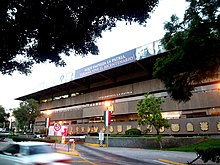
At present, the parties with the greatest presence in Tijuana are the National Action Party (PAN), Institutional Revolutionary Party (PRI), and Ecologist Green Party of Mexico (PVEM). The PAN has been the dominant party in the city for 20 years. Historically the PRI had been the dominant party in regional politics, until 1989 when the PAN began to dominate the city, until yet again, in 2004, PRI began regaining prominence and won the Mayor's Office.
Less prominent parties also maintain relations with the dominant parties. These other parties, with less presence include the New Alliance Party (PANAL), Social Encounter Party (PES), and Party of the Democratic Revolution (PRD). Allied with the PAN at the state and local level under the Alliance for Baja California are the Social Encounter Party (PES) and New Alliance Party (PANAL). Allied with the PRI at the state and local level under the "Alliance for Better Living" are the Ecologist Green Party of Mexico (PVEM) and Baja California State Party (PEBC).
Tijuana's importance and rise to a global city has led to its recognition among countries worldwide. In addition to international cultural recognition, Tijuana has received political recognition and is a developing a political center currently host to eight consulates from European, Asian and North American countries.
Economy

Tijuana is the economic center of Baja California and an important center for international trade in The Californias. The city is one of North America's most prominent manufacturing centers, as well as a major tourist destination.
Plaza Rio Tijuana is a large regional mall anchored by Cinépolis, Sanborns, Súper DAX and Sears. An important concentration of commercial plazas is in the Cinco y Diez around an eponymous intersection, named for a former American-style five and dime store that was located there. It is also a major hub for public transit. Plaza Carrousel, with its namesake merry-go-round, is located here.
Tijuana, along with the nearby Valle de Guadalupe, has recently become a culinary hotspot due to its Baja Med cuisine, including chefs such as Javier Plascencia, but also for its tacos, other street food, food trucks, coffee houses and artisanal beer.
Tijuana receives 2.5 million medical tourists per year.
Tourism
Tijuana also relies on tourism for a major part of its revenue. About 300,000 visitors cross by foot or car from the San Ysidro point of entry in the United States every day. Restaurants and taco stands, pharmacies, bars and dance clubs, and shops and stalls selling Mexican crafts and souvenirs are part of the draw for the city's tourists, many located within walking distance of the border. The city's tourist centers include Downtown Tijuana including the nightlife hot spots around La Sexta, Avenida Revolución, souvenir shopping at the Mercado de Artesanías and Plaza Viva Tijuana, Tijuana's Cultural Center (CECUT) and neighboring Plaza Río Tijuana shopping center, and the city's best known vices, in the form of its legal Red Light District and gambling (Agua Caliente). Tijuana is also known for being the birthplace of the Caesar salad. Mexico's drinking age of 18 (vs. 21 in the United States) makes it a common weekend destination for many high school and college aged Southern Californians who tend to stay on Avenida Revolución.
Tijuana is also known for its red-light district Zona Norte (also referred to as La Coahuila after one of its main streets) with legal prostitution in strip clubs and on the street. The strip clubs are typically full-contact, meaning the dancers let patrons fondle them. Many dancers also sell their sexual services. In a 1999 estimation, there were 15,000 women engaged in prostitution in Tijuana outside of clubs and brothels.
Tijuana has many pharmacies that target visitors from the United States, which sell some medicines without prescriptions and/or at much lower costs than in the U.S. Many medications still require a Mexican prescription, which can be obtained from adjacent doctors' offices. People filling up prescriptions for drugs classified in the US as Schedule II or Schedule III have found it more difficult to locate such medications, and the purchase of pseudoephedrine also has become restricted by Tijuana pharmacies, just as in the U.S. To fill a prescription in Tijuana for any drug covered by the US Controlled Substances Act and legally bring it into the United States requires a prescription from the United States for re-import. Americans can import up to a 90-day supply of non-controlled medications for personal use to the US from Mexico and other countries.
Businesses such as auto detailing, medical and dental services and plastic surgery are heavily marketed, and are usually much less expensive than in the U.S.
Tijuana is headquarters for Mexico's largest gambling concern, Grupo Caliente, which operates the only casinos in the city, more than twenty branches.
Tourists are sometimes robbed by municipal police.
Manufacturing
Tijuana is a large manufacturing center, and in addition to tourism, it serves as a cornerstone of the city economy. In the past decade alone, Tijuana became the medical device manufacture capital of the North American continent, surpassing previous leader Minneapolis–Saint Paul. Recently Scantibodies announced a new plant of 130,000 m2 devoted to manufacturing of medical devices The new plant is a build to suit by FINSA
Tijuana's proximity to Southern California, and the city's large, skilled, diverse, and relatively inexpensive workforce, make it an attractive city for foreign companies looking to establish extensive industrial parks composed of assembly plants that are called maquiladoras, even more so than other cities in the US-Mexican border zone, taking advantage of the North American Free Trade Agreement (NAFTA) to export products. At its peak, in 2001 Tijuana had roughly 820 of these 'maquiladoras'. Foreign and domestic companies employ thousands of employees in these plants, usually in assembly-related labor. Such jobs are not demanding but typically offer above average salaries for Mexico, with most maqiladoras jobs beginning at MX$100 per day (about 5 US dollars, as of September 2016), significantly above the Mexican minimum wage of Mex$57.46 (about 3 US dollars, as of September 2016). Companies that have set up maquiladoras in Tijuana include Medtronic, Lanix, Hyundai, Sony, Vortec, BMW, Vizio, Toyota, Dell, Samsung, Kodak, Matsushita/Panasonic, GE, Nabisco, Ford, Microsoft, Cemex, Zonda, Philips, Pioneer, Airbus, Plantronics, Siemens Mexico, Jaguar, Sanyo and Volkswagen. Many of the maquiladoras are located in the Otay Mesa and Florido sections of Tijuana. Economic development has its central business district at Zona Río, which together, with the corridor along Blvd. Agua Caliente (the extension of Avenida Revolución), contains the majority of the higher-end office space in the city.
Education

This section needs additional citations for verification. (April 2022) |
Tijuana is home to many private Primary Schools, Secondary Schools and High Schools as well as nationally high-ranked colleges and universities.
The Instituto México is a notable secondary school.
Higher education
Universities in Tijuana include:
- Autonomous University of Baja California, Tijuana
- Ibero-American University
- Xochicalco University
- Cetys Universidad, Tijuana
- Tijuana Institute of Technology
- UNIVERSITAM Technology University
Culture
This section needs additional citations for verification. (May 2021) |


